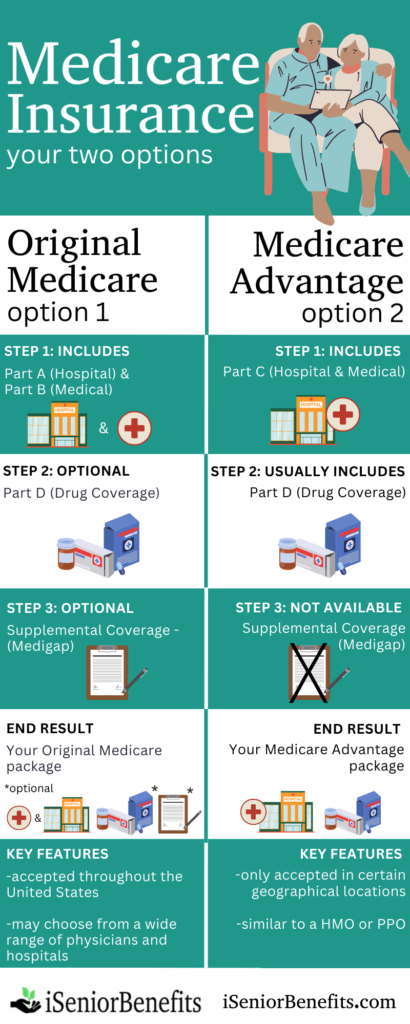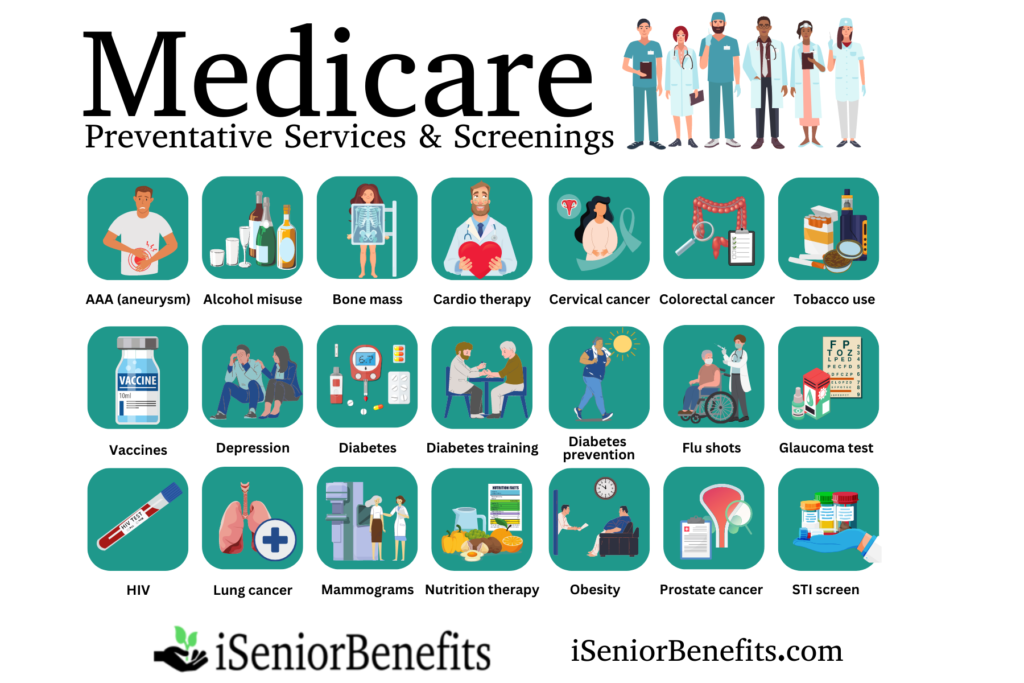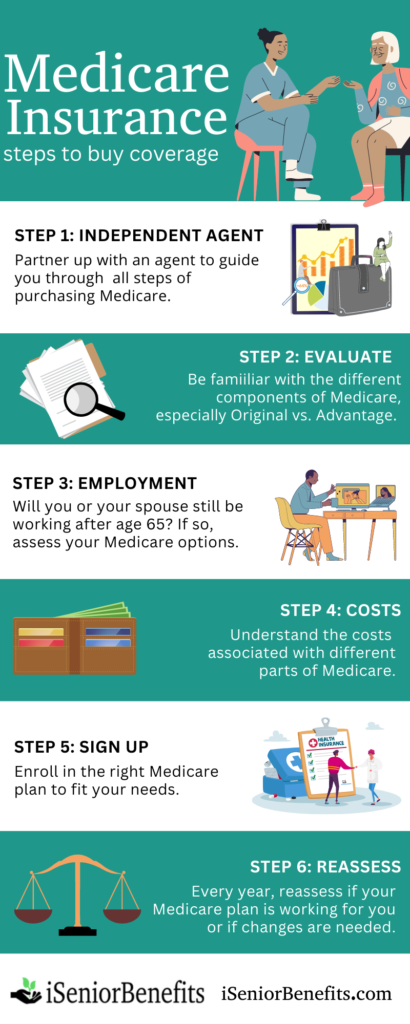Medicare

Medicare’s enrollment period often brings on one of two state-of-minds. Either trepidation and bewilderment, or confidence and assurance.
The latter is accomplished through education and preparation.
Medicare is intricate. Yet, if you break down its features into a couple main categories, like we will do here, you’ll have an excellent plan for buying coverage.
Consider this your go-to guide to understanding the ins and outs of Medicare. You will compare and contrast your purchasing options and understand how to select the best Medicare plan to fit your needs.
Table Of Contents
Medicare Insurance Overview
Medicare is our federal government’s health insurance program.
At its inception in 1965, it was deemed a one-size-fits-all insurance plan for eligible employees to enroll in at age 65.
Times have changed. Today, there are well over 50 Medicare options available on the marketplace, partly due to the privatization of the program in the 1990s.
Individuals qualify for Medicare health insurance under the following circumstances:
- People 65 or older.
- Those with a qualifying disability.
- Have End-Stage Renal Disease (ESRD).
- Diagnosed with ALS (Lou Gehrig’s disease).
You may sign up for Medicare three months before turning 65.
Note – If you do not meet any of the criterion for Medicare enrollment, plenty of health insurance options exist.
There are four primary parts to Medicare’s program:
- Part A – Hospital Insurance. Covers inpatient care in hospitals or certain nursing facilities. Also helps pay for hospice and home health care.
- Part B – Medical Insurance. Covers doctor appointments, outpatient and home health care. Also helps pay for medical equipment and screenings.
- Part C – Medicare Advantage. Health plan offered through private companies. A packaged plan that covers Parts A, B and often D.
- Part D – Drug coverage. Covers prescription drugs, vaccinations. Offered through private companies.
The best way to wade through the vast amount of choices and determine the right Medicare insurance plan for you is to annually evaluate your:
- Medical insurance needs.
- Other existing medical coverage, if any.
- Budget for medical insurance.
- Preferred physicians and hospitals.
Medicare Options
To start, you must know there are two foundational paths to securing Medicare coverage.
- Original Medicare
- Medicare Advantage
Important – other health insurance coverage options exist through unions, the military, or veterans’ benefits. Medicare has the ability to coordinate with other forms of coverage.

Original Medicare
By default, you will be enrolled in Original Medicare unless you opt for Medicare Advantage.
You will have the ability to go to any doctor or hospital in the United States that accepts Medicare. A referral is typically not needed.
Costs associated with Original Medicare:
- You pay a monthly premium for Part B.
- After you meet your deductible, you usually pay a coinsurance amount of 20% for Part B services.
- There is not a limit for out-of-pocket expenses, unless you purchase supplemental coverage (Medigap).
Coverage features of Original Medicare:
- Most medically necessary services and supplies in hospitals, doctors’ offices, and health care facilities are covered. (Most dental, vision, and hearing services are excluded.)
- You will need to join a separate drug plan (Part D) to get Medicare drug coverage.
- Typically, pre approval is not required for services or supplies.
Important – Original Medicare usually does not cover medical care outside of the United States. Consider a Medigap policy that will cover emergency care beyond the U.S.
Medicare Advantage
An alternative to Original Medicare, Medicare Advantage allows you to purchase coverage through a private healthcare company.
Medicare Advantage is close to becoming the predominant way that Medicare beneficiaries get their health coverage and care.
Kaiser Family Foundation
Generally speaking, Medicare Advantage only allows you to use doctors and other providers in the plan’s network and service area (for non-emergency care).
Some Medicare Advantage plans do offer non-emergency out-of-network coverage, but these plans usually cost more.
Often, a referral is required to see a specialist.
Costs associated with Medicare Advantage:
- Your out-of-pocket costs will vary depending on your specific plan.
- You will pay a monthly Part B premium, and you might have to pay the plan’s premium.
- The majority of plans include Part D, Medicare drug coverage.
- There is a yearly spend limit for what you pay out-of-pocket. After the limit is reached, services related to Part A and Part B are covered for the remainder of the year.
- Medigap is not an option with Medicare Advantage.
Coverage features of Medicare Advantage:
- Plans cover all medically necessary services that Original Medicare covers.
- Additional benefits may be covered that are not included in Original Medicare (like vision, hearing, or dental).
- Drug coverage (Part D) is included in most plans.
- Typically, pre-approval (a referral) is required.
Important – Medicare Advantage usually does not cover medical care outside of the United States. Certain plans offer a supplemental benefit that covers medical emergencies that occur outside of the U.S.
With the help of an insurance expert, you can confidently weigh your options and select the best plan to fit your needs. Plan to reevaluate every year.
Note – Detailed information is found in the Medicare and You Handbook
FAQs
Consider the following frequently asked questions pertaining to Medicare coverage.
Do I have to enroll when I turn 65?
Not necessarily.
But, you can be penalized for not enrolling if you don’t have adequate coverage through your employer.
Who pays for Medicare?
Run by the Centers for Medicare and Medicaid Services (CMS), the federal program is funded by Social Security and Medicare taxes, premiums participants enrolled in Medicare pay, and through the federal government.
What does Medicare Part A and Part B not cover?
Medicare law prevents coverage for the following:
- Routine physical exams
- Long-term Care
- Most dental care
- Dentures
- Hearing exams and hearing aids
- Eye exams and glasses
- Cosmetic surgery
- Massage therapy
- Concierge care
- Covered items or services you get from an opt-out physician
Note – Since most plans do not include dental, vision, and hearing insurance, be sure to evaluate plans outside of Medicare for the health of your teeth, eyes, and ears.
Important – Medicare Advantage or a Medicare Cost Plan (only available in certain geographic locations) have the ability to cover some of the above services, depending on the plan’s specific features.
What preventative services does Medicare cover?
Medicare provides comprehensive prevention services.

- Abdominal aortic aneurysm screenings
- Alcohol misuse screenings and counseling
- Bone mass measurements
- Cardiovascular behavioral therapy
- Cervical and vaginal cancer screenings
- Colorectal cancer screenings
- Counseling to prevent tobacco use and tobacco-caused disease
- Vaccines
- Depression screening
- Diabetes screenings
- Diabetes self-management training
- Flu shots
- Glaucoma tests
- HIV screenings
- Lung cancer screenings
- Mammograms
- Medicare Diabetes Prevention Program
- Nutrition therapy services
- Obesity behavioral therapy
- Prostate cancer screenings
- STI screenings
- Yearly “Wellness” visit (not a physical exam)
What are important dates I should be aware of?
Mark your calendar for the following Medicare dates:
- October 15 – December 7: Open Enrollment Period.
- January 1: New coverage begins, if a change was made to your plan.
- January 1 – March 31: If you have a Medicare Advantage Plan, you can change to a different Medicare Advantage plan or switch to Original Medicare (and join a Medicare drug plan).
Be sure to review your Medicare plan annually and make necessary changes to meet your needs.
How important are Medigap policies, if I enroll in Original Medicare?
Quite.
Medigap policies will cover some or all of the out-of-pocket costs that your Original Medicare plan does not.
Offered through a private insurer, Medigap policies can safeguard your finances.
How to Buy Medicare Insurance
Plan to take six important steps during the purchasing process of Medicare insurance.

1. Independent Agent
By far, the most important first step to take is to partner up with an independent health insurance agent. They will guide you through the process of evaluating your needs, budget, and the assessment of different Medicare insurance carriers.
For example, an agent will walk you through the complex nature of purchasing health insurance through Medicare by evaluating:
- The strength and features of different carriers offering Medicare.
- Your healthcare needs.
- Costs associated with different plans.
- Your desired physicians and hospital.
2. Evaluate
Next, you will want to evaluate the various components and features of Medicare’s plans. Determine whether Original Medicare or Medicare Advantage meets your needs.
If you decide on Original Medicare, analyze whether you would like to add drug coverage (Part D) and/or Supplement Insurance (Medigap).
Pertaining to Part D, ask yourself:
- Do I currently take medications?
- What if my health changes and prescription drugs are required in the future?
Pertaining to Medigap, ask yourself:
- What is my budget for supplemental insurance?
- Will health problems prevent me from buying Medigap in the future, after open enrollment?
Important – Part D and Medigap only apply to Original Medicare.
3. Employment
If you or your spouse plan to work after age 65, your Medicare requirements and options can be affected.
For example, you will need to determine:
- Whether you currently have health insurance through your or your spouse’s employer.
- If your or your spouse’s employer provides healthcare coverage to 20 or more employees.
Again, a health insurance agent who specializes in Medicare will guide you through these important determinations.
4. Costs
Your healthcare budget is a necessary factor to understanding which Medicare insurance plan works best for you.
For example, for Original Medicare:
- You pay a monthly premium.
- Most out of pocket costs are covered.
On the other hand, for Medicare Advantage:
- Copays are required.
- Structured similar to a PPO or HMO.
5. Sign Up
Upon turning 65, there is a 7-month window of time (that starts 3 months before your 65th birthday) in which you can enroll into Medicare.
After the initial enrollment period, general enrollment occurs every fall, in mid-October through the first week of December. This is your annual opportunity to make adjustments to your Medicare plan.
From time to time, there are exceptions beyond the initial and general enrollment periods. If you leave your job or move to an area outside of your plan’s coverage, special enrollment periods apply.
Note – if you receive Social Security benefits before turning 65, you will be automatically enrolled into Parts A and B of Medicare.
6. Reassess
Every year, you will want to reassess your Medicare insurance plan.
Ask yourself the following questions:
- Am I receiving the type of medical care I want?
- Do I have access to the physicians and hospitals I prefer?
- Are my medications covered in my plan?
- Is my healthcare budget reasonable?
Our health insurance needs change with each passing year, and it is worthwhile to determine if adjustments should be made to your plan on an annual basis.